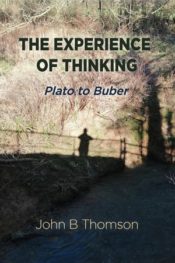Waldorf News
The Experience of Thinking: Plato to Buber by John B. Thomson

The Experience of Thinking: Plato to Buber
By John B. Thomson
Alkion Press, 2022
Reviewed by Eric G. Müller
This book is not a history of philosophy from Plato to Buber. It is rather a personal journey and an attempt to show the different ways of thinking that philosophers have adopted in building their world-views. For some, the starting place is the mind with reasoning and introspection. For others, observations in the world of sense impressions provide the point of departure. Both activities are usually present but in different proportions. ~ John B. Thomson
John Thomson takes the reader on a fascinating journey that follows the development of consciousness from pictorial thinking of the ancients right up to the mode of conceptual thinking that underlies our present culture.
We know these philosophers, but the red thread that runs through the evolution of thinking is often missing in our time. John includes that vital element which sheds light on the philosophies, putting them into context.
The seeds of the book go back to the years following World War II. John bought a copy of Buber’s I and Thou, followed with Rudolf Steiner’s Philosophy of Freedom, which made him ponder on the nature of thinking. They were seminal in his lifelong pursuit of philosophy. The first incarnation of the present book came in the form of lectures given in a pub, which were recorded and made into podcasts years later.
I wondered whether they were available in book form, which they weren’t. In Waldorf high schools, we teach the development of consciousness through art, drama, poetry, music and architecture, and I was immediately intrigued by the idea of tracing the evolution of consciousness through philosophy. I offered to publish the lectures through Alkion Press.
John agreed and – dissatisfied with the audio-transcripts – rewrote the entire material, without losing the flavor of the spoken word, a remarkable effort for a man in his mid-nineties. The book is a spiritual legacy of sorts, and the profound questions and insights that he shares are the result of a lifetime of accumulated wisdom. It is written in a personable manner, honed by his years as a Waldorf teacher.
John depicts the distilled essence of each philosopher, the disparate world-views offering contrasting perspectives, highlighting the nodal points that reflect the shifts in consciousness right up to our modern era. He guides our understanding through the thought life of the respective philosophers, which effectively impart health-giving properties to our mental life.
The book highlights how some philosophers focus more on the world while others emphasize the self. What’s important, however, is to follow their line of thought, “rather than any permanent set of beliefs.”
John underscores how crucial it is to understand our present age in order to meet the demands of the future. “The natural sciences bring new consciousness in which nothing from the human soul is allowed to interfere with the understanding of the natural world. The ‘I’ plays no role in the created world except to explain it.”
This mindset has contributed to feelings of alienation from the world and has led to a sense of “anxiety and loneliness.” However, it also gives us the possibility to engage responsibly and freely with the world and our inner lives, born from the strength of our own “I.” This book has the potential to reshape our lives and it certainly stimulates the experience of thinking.
 Association for a Healing Education
Association for a Healing Education Everything a Teacher Needs
Everything a Teacher Needs Full-Time Teacher Education
Full-Time Teacher Education Space speaks. Its language is movement.
Space speaks. Its language is movement. Immersive Academics and Arts
Immersive Academics and Arts The Journey is Everything
The Journey is Everything Bringing Love to Learning for a Lifetime
Bringing Love to Learning for a Lifetime Summer Programs - Culminating Class Trips
Summer Programs - Culminating Class Trips Middle School Science With Roberto Trostli
Middle School Science With Roberto Trostli Transforming Voices Worldwide
Transforming Voices Worldwide Waldorf EC Training & Intensives in Canada
Waldorf EC Training & Intensives in Canada Apply Today: New Cohort Starts Nov. 2025
Apply Today: New Cohort Starts Nov. 2025 Roadmap to Literacy Books & Courses
Roadmap to Literacy Books & Courses Discovering the Wisdom of Childhood
Discovering the Wisdom of Childhood ~ Ensoul Your World With Color ~
~ Ensoul Your World With Color ~ Storytelling Skills for Teachers
Storytelling Skills for Teachers Flexible preparation for your new grade
Flexible preparation for your new grade Jamie York Books, Resources, Workshops
Jamie York Books, Resources, Workshops Caring for All Stages of Life
Caring for All Stages of Life Bay Area Teacher Training
Bay Area Teacher Training Grade Level Training in Southern California
Grade Level Training in Southern California Train to Teach in Seattle
Train to Teach in Seattle Quality Education in the Heartland
Quality Education in the Heartland The Art of Administration and Leadership
The Art of Administration and Leadership Art of Teaching Summer Courses 2025
Art of Teaching Summer Courses 2025 Dancing for All Ages
Dancing for All Ages Waldorf-inspired Homeschool Curriculum
Waldorf-inspired Homeschool Curriculum RSS Feeds
RSS Feeds